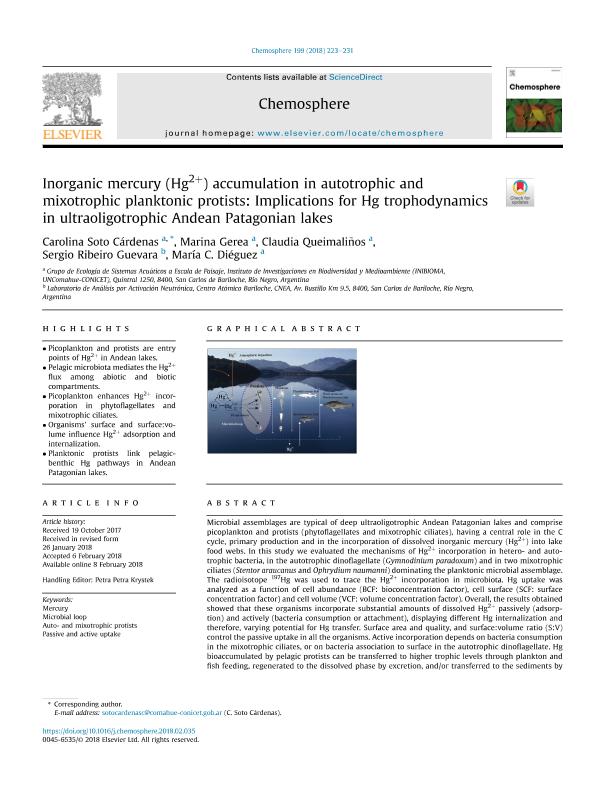Artículo
Inorganic mercury (Hg2+) accumulation in autotrophic and mixotrophic planktonic protists: Implications for Hg trophodynamics in ultraoligotrophic Andean Patagonian lakes
Soto Cárdenas, Estela Carolina ; Gerea, Marina
; Gerea, Marina ; Queimaliños, Claudia Patricia
; Queimaliños, Claudia Patricia ; Ribeiro, Sergio; Dieguez, Maria del Carmen
; Ribeiro, Sergio; Dieguez, Maria del Carmen
 ; Gerea, Marina
; Gerea, Marina ; Queimaliños, Claudia Patricia
; Queimaliños, Claudia Patricia ; Ribeiro, Sergio; Dieguez, Maria del Carmen
; Ribeiro, Sergio; Dieguez, Maria del Carmen
Fecha de publicación:
05/2018
Editorial:
Pergamon-Elsevier Science Ltd
Revista:
Chemosphere
ISSN:
0045-6535
Idioma:
Inglés
Tipo de recurso:
Artículo publicado
Clasificación temática:
Resumen
Microbial assemblages are typical of deep ultraoligotrophic Andean Patagonian lakes and comprise picoplankton and protists (phytoflagellates and mixotrophic ciliates), having a central role in the C cycle, primary production and in the incorporation of dissolved inorganic mercury (Hg2+) into lake food webs. In this study we evaluated the mechanisms of Hg2+ incorporation in hetero- and autotrophic bacteria, in the autotrophic dinoflagellate (Gymnodinium paradoxum) and in two mixotrophic ciliates (Stentor araucanus and Ophrydium naumanni) dominating the planktonic microbial assemblage. The radioisotope 197Hg was used to trace the Hg2+ incorporation in microbiota. Hg uptake was analyzed as a function of cell abundance (BCF: bioconcentration factor), cell surface (SCF: surface concentration factor) and cell volume (VCF: volume concentration factor). Overall, the results obtained showed that these organisms incorporate substantial amounts of dissolved Hg2+ passively (adsorption) and actively (bacteria consumption or attachment), displaying different Hg internalization and therefore, varying potential for Hg transfer. Surface area and quality, and surface:volume ratio (S:V) control the passive uptake in all the organisms. Active incorporation depends on bacteria consumption in the mixotrophic ciliates, or on bacteria association to surface in the autotrophic dinoflagellate. Hg bioaccumulated by pelagic protists can be transferred to higher trophic levels through plankton and fish feeding, regenerated to the dissolved phase by excretion, and/or transferred to the sediments by particle sinking. In ultraoligotrophic Andean Patagonian lakes, picoplankton and planktonic protists are key components of lake food webs, linking the pelagic and benthic Hg pathways, and thereby playing a central role in Hg trophodynamics.
Archivos asociados
Licencia
Identificadores
Colecciones
Articulos(INIBIOMA)
Articulos de INST. DE INVEST.EN BIODIVERSIDAD Y MEDIOAMBIENTE
Articulos de INST. DE INVEST.EN BIODIVERSIDAD Y MEDIOAMBIENTE
Citación
Soto Cárdenas, Estela Carolina; Gerea, Marina; Queimaliños, Claudia Patricia; Ribeiro, Sergio; Dieguez, Maria del Carmen; Inorganic mercury (Hg2+) accumulation in autotrophic and mixotrophic planktonic protists: Implications for Hg trophodynamics in ultraoligotrophic Andean Patagonian lakes; Pergamon-Elsevier Science Ltd; Chemosphere; 199; 5-2018; 223-231
Compartir
Altmétricas



